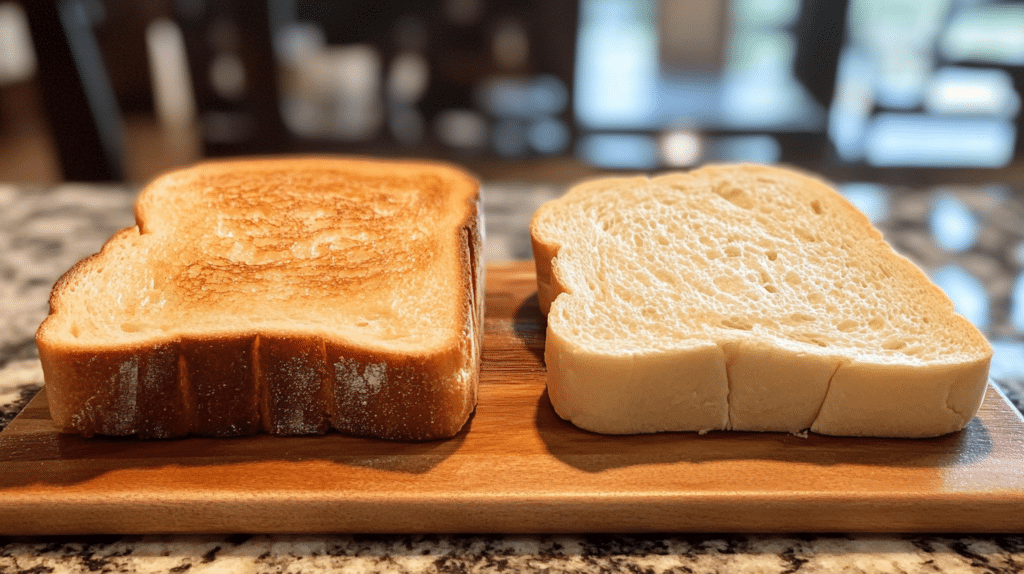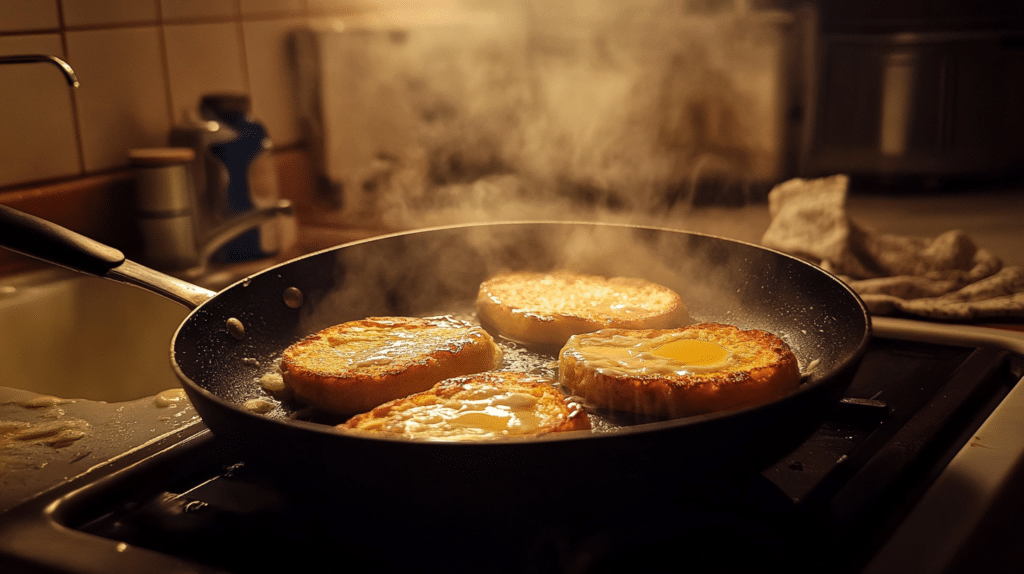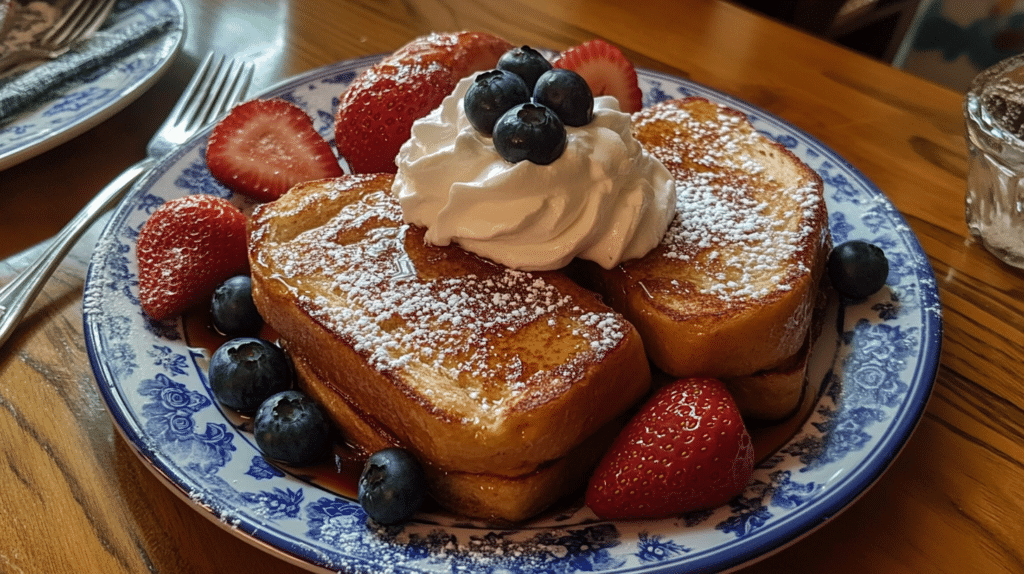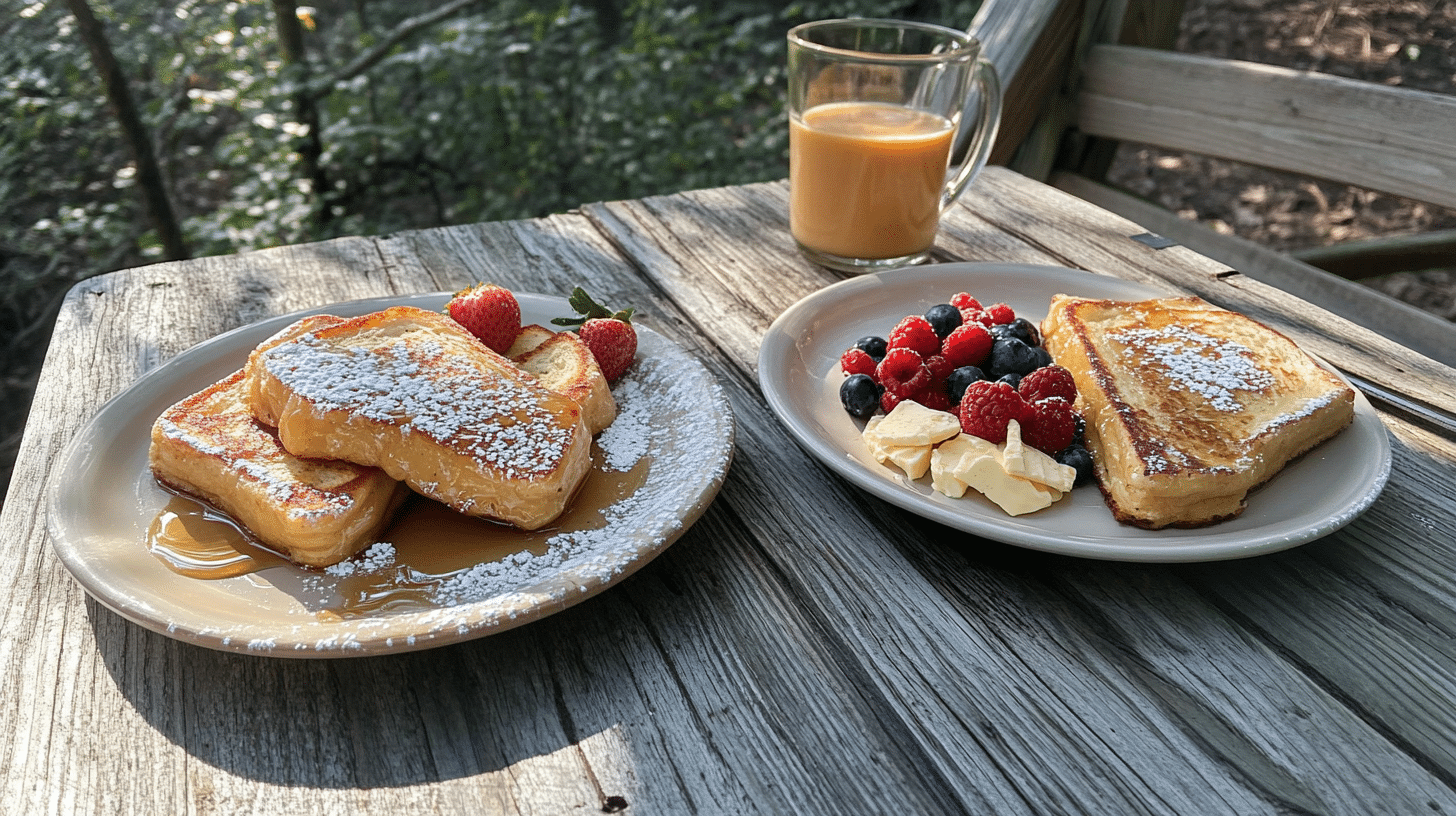In the world of breakfast delights, French toast holds a cherished spot as a classic comfort food. Its sweet, custardy flavor and golden-brown crust make it a popular choice for people of all ages. However, when you hear the term “Texas French toast,” you might wonder how it differs from the traditional version. This article explores the difference between Texas toast and French toast, highlighting their unique characteristics, preparation methods, and cultural significance.
Table of Contents
Introduction
French toast is a time-honored breakfast dish that has been enjoyed across cultures for centuries. At its core, it involves soaking slices of bread in a mixture of eggs and milk before frying them to perfection. The dish has evolved significantly over time, with countless variations appearing in different regions of the world.
Texas French toast, on the other hand, is a distinctly American twist on the traditional recipe. It uses Texas toast—a thick-cut bread that creates a heartier, fluffier version of the dish. While both share the same basic preparation method, they differ in texture, presentation, and cultural context.
Understanding the differences not only deepens your appreciation for these dishes but also enhances your cooking skills. Whether you’re a culinary enthusiast or simply a breakfast lover, this exploration will inspire you to try both styles.
What is French Toast?
French toast, known in France as pain perdu, meaning “lost bread,” has origins dating back to ancient Rome. Its original purpose was to repurpose stale or “lost” bread by soaking it in a mixture of eggs and milk before frying it, creating a dish that was both economical and delicious. Over time, French toast became a staple in many cuisines, celebrated for its versatility and simplicity.
Traditional Ingredients
The foundation of French toast lies in a few simple yet essential ingredients:
- Bread: Any type of bread can be used, but softer breads like brioche, challah, or white sandwich bread are preferred for their ability to absorb the custard mixture.
- Eggs: These act as a binding agent and contribute to the custard-like consistency of the dish.
- Milk: Combined with eggs, milk helps create a creamy mixture. Dairy alternatives like almond milk or oat milk can also be used.
- Sugar and Spices: A touch of sugar, cinnamon, nutmeg, or vanilla extract adds flavor and aroma.
- Butter: Used for frying, butter enhances the golden-brown crust and rich taste.
Preparation Method
Making traditional French toast involves a straightforward process that highlights its simplicity:
- Mix the Custard: Whisk together eggs, milk, sugar, and optional spices like cinnamon or vanilla in a shallow dish.
- Soak the Bread: Dip each slice of bread into the mixture, allowing it to absorb the liquid without becoming soggy.
- Cook: Melt butter in a skillet over medium heat and cook the bread slices until golden brown on both sides, about 2–3 minutes per side.
- Serve: Top with powdered sugar, syrup, fresh fruit, or whipped cream.
What is Texas French Toast?
Texas French toast builds on the foundation of classic French toast but takes it to new heights—literally. The defining feature of this variation is the use of Texas toast, a type of bread that is significantly thicker than standard sandwich bread. Texas toast often measures about twice the thickness of traditional sliced bread, making it ideal for soaking up custard and creating a fluffier texture.
Unique Ingredients
Texas French toast stands out because of the bread itself:
- Texas Toast: This bread’s thick slices can absorb more custard without falling apart. Its density and slightly chewy texture provide a more substantial bite compared to regular French toast.
- Butter and Toppings: While Texas French toast is prepared similarly to traditional French toast, its toppings often include hearty options like flavored syrups, cream cheese, or even savory additions like bacon or sausage on the side.
Preparation Method
The preparation of Texas French toast follows the same steps as traditional French toast but includes some adjustments to account for the thicker bread:
- Prepare the Custard: Whisk together eggs, milk, and flavoring ingredients in a shallow dish.
- Soak the Bread: Because Texas toast is thicker, allow the bread to sit in the mixture slightly longer to ensure it absorbs the custard evenly.
- Cook Thoroughly: Cook the bread slices on medium heat for 3–4 minutes per side to ensure the center is fully cooked while the outside is golden and crispy.
- Serve Generously: Texas French toast is often served with bold toppings like peanut butter, fruit compotes, or decadent sauces.
Key Differences
While the two dishes share a similar foundation, their variations in bread type, texture, preparation, and presentation set them apart. Let’s dive into the specifics that distinguish these breakfast favorites.
Bread Type and Thickness
One of the most noticeable differences lies in the choice of bread:
- Traditional French Toast: Typically made with thinner slices of bread like brioche, challah, or white sandwich bread. These softer options absorb the custard quickly and create a tender texture.
- Texas-Style Variation: Uses Texas toast, a bread that’s almost twice as thick as regular slices. This extra thickness creates a more robust and fluffy dish, allowing it to soak up more custard without losing its shape.

Texture and Structure
The texture of the dish is influenced greatly by the bread:
- Traditional French Toast: Light and slightly crispy on the outside, with a tender, custard-like interior. It often has a delicate texture that pairs well with lighter toppings like powdered sugar and fruit.
- Texas French Toast: Thick and substantial, offering a chewy bite with a fluffy center. The thicker bread retains a soft core while achieving a crispy outer layer when cooked properly. This makes it a more filling option.
Preparation Techniques
Although the preparation method for these two dishes follows the same general steps, the thicker bread in Texas-style French toast calls for a few adjustments:
- Custard Absorption: Classic French toast requires only a quick dip in the custard mixture, whereas thicker slices like Texas toast benefit from a longer soaking time to ensure the custard fully permeates the bread.
- Cooking Time: The extra thickness of Texas-style toast means it takes longer to cook. Lower heat is often preferred to thoroughly cook the interior without over-browning the exterior.
- Frying Method: Both versions use butter for frying, but the larger, thicker slices may need additional butter to achieve a consistent golden-brown crust.

Serving Styles
The presentation and accompaniments of each dish also differ:
- Traditional French Toast: Often presented with simple toppings like powdered sugar, maple syrup, or fresh berries. It’s a versatile dish that can be dressed up for brunch or kept minimal for a quick breakfast.
- Texas French Toast: Due to its substantial size, this dish is often paired with richer toppings like whipped cream, caramel sauce, or cream cheese. It’s a favorite in American diners and is often served as part of a larger breakfast platter with eggs, bacon, or sausage.
Flavor Profiles
While both versions share a custardy flavor, the thicker bread in Texas French toast alters the overall taste experience:
- Traditional French Toast: Balanced flavors with a slightly eggy custard center and crisp edges, allowing the toppings to shine.
- Texas French Toast: More robust and buttery, with a prominent bread flavor due to the thicker slices. The toppings often complement the heartiness of the dish rather than overpower it.
Cultural Significance of Each Dish
Food is more than sustenance; it’s a reflection of history, culture, and creativity. French toast, along with its Texan variation, holds cultural and regional significance, showcasing their unique roles in diverse culinary traditions. This timeless dish has adapted to suit tastes and traditions across the globe.
French Toast in Global Cuisines
Variations of French toast appear in many cultures worldwide, each bringing its own flavor and flair:
This revision avoids repetitive sentence beginnings while maintaining clarity and flow.
- European Roots: In France, pain perdu was traditionally a way to use stale bread and avoid waste. The dish is celebrated for its simplicity and adaptability, often served as a dessert or indulgent breakfast.
- Middle Eastern Variants: Similar recipes, like Eish Saraya, are soaked in sweetened milk or syrup, reflecting the regional preference for richer flavors.
- Asian Adaptations: In countries like Japan, French toast is often made with milk bread (shokupan) and served as a dessert with ice cream or custard.
These global variations emphasize how French toast transcends borders, offering a canvas for local ingredients and tastes.
Texas French Toast in American Dining Culture
Texas French toast is a quintessentially American creation, rooted in the bold flavors and larger portions that define Texan cuisine. Its thick slices and hearty preparation embody the spirit of indulgence and comfort that American breakfasts are known for.
- Diner Staple: Texas French toast is a popular menu item at diners and breakfast joints across the United States, often served alongside classic breakfast sides like eggs and bacon.
- Home Comfort: The dish is a favorite for family breakfasts, especially during weekends or holidays, due to its filling nature and easy preparation.
- Versatility: Texas French toast’s robust nature makes it a perfect base for experimenting with creative toppings, from savory bacon jams to decadent chocolate sauces.
Regional Preferences and Adaptations
- Southern Style: Often served with a dollop of butter and a generous pour of maple syrup or honey.
- Southwestern Flair: Some versions include a savory twist with jalapeño-infused butter or a side of spiced sausage.
- Coastal Influence: In areas near the coasts, Texas French toast might feature tropical toppings like coconut shavings or pineapple compote.
Common Misconceptions
Despite their popularity, both French toast and Texas French toast are sometimes misunderstood. Let’s clear up a few misconceptions:
Is Texas French Toast Just Thicker Bread?
While the bread is indeed thicker, Texas French toast is more than a simple substitution. The thickness of Texas toast allows for unique preparation methods, longer soaking times, and a different texture that distinguishes it from traditional French toast.
French Toast is Always Sweet.
While French toast is typically sweetened, savory versions exist in many cultures. For example, Spanish torrijas can be made with olive oil and garlic, while some American diners offer French toast with cheese or meat toppings.
Texas French Toast Is Not Just a Regional Specialty
Despite its name, this dish is not confined to Texas or Texan cuisine. Instead, the term refers to the use of Texas toast, a thick-cut bread that forms the base of this variation. Its popularity extends across the United States, making it a favorite on breakfast menus nationwide.
Each Version Serves a Unique Purpose
Although they share the same foundational ingredients, these two styles of French toast are far from interchangeable. The thicker slices and substantial texture of the Texas-style version make it a great choice for hearty, indulgent meals. In contrast, traditional French toast, with its lighter and more delicate qualities, suits versatile recipes and simpler presentations.

FAQs
Is Texas French Toast Just a Thicker Version of French Toast?
Not entirely. While thickness is a key difference, Texas-style French toast also involves slight adjustments in its preparation. The thicker Texas toast requires a longer soak in the custard to ensure it absorbs the mixture evenly and needs more time on the skillet to cook through. These changes result in a fluffier, more robust dish compared to the lighter, custard-forward traditional French toast.
Can You Use Regular Bread for Texas French Toast?
Yes, you can use regular bread, but the outcome will differ significantly. The defining feature of Texas-style French toast is the use of thick Texas toast, which creates a fluffy, substantial texture and a satisfying bite. Regular bread, being thinner, won’t soak up the custard mixture as effectively and may result in a less robust dish.
Conclusion
Both Texas French toast and traditional French toast are cherished breakfast favorites, each bringing unique qualities to the table. Traditional French toast, with its airy, custardy texture and simple origins, offers an elegant choice for those who enjoy a lighter, classic meal. On the other hand, Texas French toast transforms the recipe with its thick-cut bread, creating a more indulgent and substantial dish that satisfies heartier appetites.
For a deeper exploration of creative French toast recipes, you might enjoy our guide to the Sourdough French Toast Recipe – The Ultimate Guide. If you’re interested in comparing other iconic breakfast or dessert treats, our article on What is the Difference Between a Cinnamon Roll and a Pershing Donut? is a must-read. Finally, for bread lovers curious about unique uses of dough, check out What is a Bread Roll Shaped Like a Doughnut Called?.
Understanding the distinctions between these two variations not only deepens your appreciation for their culinary artistry but also inspires innovation in the kitchen. Whether you gravitate toward the refined simplicity of traditional French toast or the rich, satisfying appeal of Texas French toast, both promise a delightful start to your day. Why not explore both styles and find your ultimate favorite?

